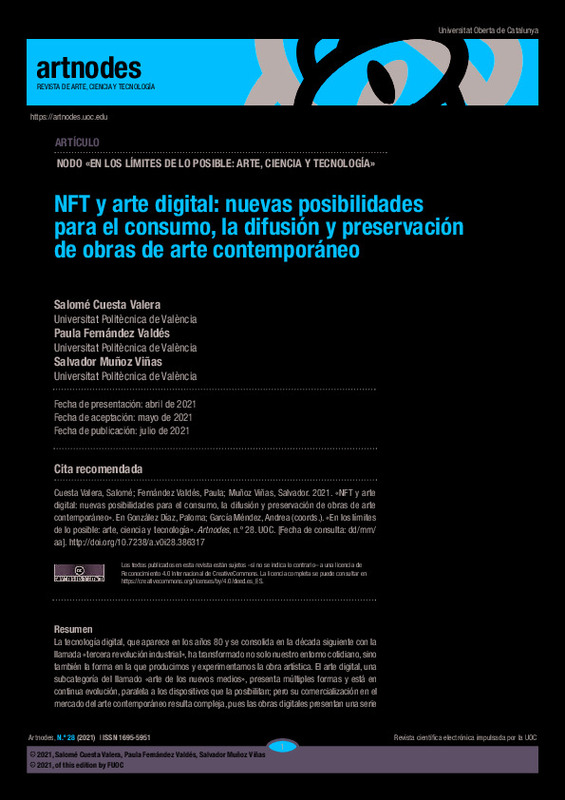|
Resumen:
|
[EN] Digital technology, which appeared in the `80s and consolidated itself in the following decade with what was called
the ¿third industrial revolution¿, has transformed not only our daily environment, but also the way ...[+]
[EN] Digital technology, which appeared in the `80s and consolidated itself in the following decade with what was called
the ¿third industrial revolution¿, has transformed not only our daily environment, but also the way in which we produce
and experience the artistic work. Digital art, a subcategory of the so-named art of the new media, presents multiple
forms and is in continual evolution, parallel to the devices which make it possible; but its commercialisation in the
contemporary art market becomes complex, so digital works present a series of characteristics such as the paperless
ofice, obsolescence and reproducibility which may be considered to be not particularly profitable by collectors.
Despite this, in recent months the sale of some digital artworks, to which numerous texts are referred to under
the name of cryptoart, have increased notably, reaching figures in the millions for the first time in auction houses.
The commercial success of these pieces is due to the fact that, together with the work¿s archive, they include a
type of cryptographic certificate, the non- fungible-tokens or NFTs, which collect the the work¿s data and inscribe
them in a blockchain; transforming a multiple and disseminated work into a digital item that is unique and traceable,
whose property can be transmitted as one would do with any other object in the offline world. Although they favour in
principle the creation and sale of digital art, NFTs present their own problems, especially related to their access, use
and sustainability; are NFTs a permanent tool or only a method of fleeting speculation? How does this certification
affect property and the author¿s rights? Is it possible and will it be sustainable to employ them as a strategy for the
preservation of digital works?
This article carries out an analysis of the principal characteristics and problems of digital art in a general sense,
as well as the solutions and preoccupations which the cryptographic certificates offer in all aspects in the life of a
work of art: production, dissemination and preservation.
[-]
[ES] La tecnología digital, que aparece en los años 80 y se consolida en la década siguiente con la llamada «tercera revolución industrial», ha transformado no solo nuestro entorno cotidiano, sino también la forma en la ...[+]
[ES] La tecnología digital, que aparece en los años 80 y se consolida en la década siguiente con la llamada «tercera revolución industrial», ha transformado no solo nuestro entorno cotidiano, sino también la forma en la que producimos y experimentamos la obra artística. El arte digital, una subcategoría del llamado «arte de los nuevos medios», presenta múltiples formas y está en continua evolución, paralela a los dispositivos que la posibilitan; pero su comercialización en el mercado del arte contemporáneo resulta compleja, pues las obras digitales presentan una serie de características como la desmaterialización, la obsolescencia y la reproducibilidad que pueden ser consideradas poco rentables por los coleccionistas.
Pese a esto, en los últimos meses la venta de algunas obras de arte digital, a las que numerosos textos se refieren bajo el nombre de «criptoarte», han aumentado notablemente, alcanzando las primeras cifras millonarias en las casas de subastas. El éxito comercial de estas piezas se debe a que, junto con el archivo de la obra, incluyen un tipo de certificado criptográfico, los non- fungible-tokens o NFT, que recogen los datos de la obra y los inscriben en una cadena de bloques o blockchain; transformando una obra múltiple y difusa en un ítem digital único y rastreable, cuya propiedad puede transmitirse como se haría con cualquier otro objeto del mundo offline. Aunque favorecen en principio la creación y venta del arte digital, los NFT presentan sus propias problemáticas, relacionadas sobre todo con su acceso, uso y sostenibilidad: ¿son los NFT una herramienta permanente o solo un método de especulación pasajero? ¿cómo afecta esta certificación a la propiedad y los derechos de autor? ¿es posible y resultará sostenible emplearlos como estrategia para la preservación de obras digitales?
En el presente artículo se lleva a cabo un análisis de las principales características y problemas del arte digital en sentido general, así como de las soluciones y preocupaciones que ofrecen los certificados criptográficos en todos los aspectos de la vida de la obra de arte: producción, difusión y preservación.
[-]
|









